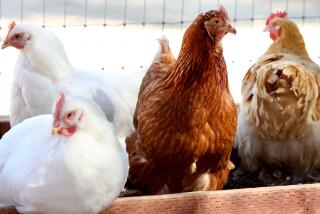Treatment of Animals on the Farm
- Share via
Wayne Pacelle’s Jan. 15 commentary, “Cruel and Unusual Punishment on the Farm,” may be accepted as fact simply because of his position with the Humane Society.
I experienced life on a small family farm in Indiana 50 years ago. My father used what is now referred to as a “gestation crate.” This served two very humane purposes. First, it prevented the sows from eating their young immediately at birth. Second, these crates had a 2-inch-by-8-inch shelf for the young pigs to get under so their 300-pound mother wouldn’t lie on them and crush them to death. We even had a heat lamp to keep them warm. After a few days the pigs could fend for themselves and the family was turned loose.
We had chickens that could enjoy the sunshine or go inside to individual straw-lined nests. They still would sometimes peck each other to death. This was eliminated by searing off the tip of the top beak. This didn’t interfere with eating grain; it just stopped the cannibalism.
Animals should be treated humanely, but the thinking that Congress should create yet another commission to watch pigs and chickens is another example of why we taxpayers can’t keep up with the spending of our federal and state governments.
Theron Collier
La Habra
*
Thank you for the space dedicated to the treatment of farm animals. Speaking for animals is as important to our morality, conscious or unconscious, as speaking out for children. Neither can speak for themselves, but the way we treat both reflects who we are as a country and individually.
Bob Hayes
Canoga Park
*
After 25 years in animal protection, I’ve come to believe that the majority of Americans would eat their own grandmother if she tasted good and was cheaper than chicken.
Eric Mills
Coordinator, Action
for Animals, Oakland
More to Read
Sign up for The Wild
We’ll help you find the best places to hike, bike and run, as well as the perfect silent spots for meditation and yoga.
You may occasionally receive promotional content from the Los Angeles Times.






